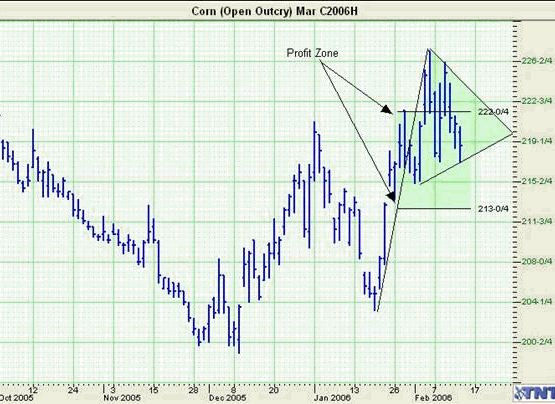Trade description
Buy one March Corn 220 call and buy one March Corn 215 put for a ridiculously cheap $200 for the spread. Options expire on Friday, February 24th, 2006. Margin and max risk is the cost of the trade.
Explanation
After a strong corn rally the market has developed a massive technical pennant formation and is consolidating ahead of what should be another breakout. The market√Ę‚,¨‚"Ęs 1 month volatility expansion as compared to its 6 or 12 month inherent volatility suggests that the option prices are grossly discounted without factoring in the near term daily price action. A short term near the money strangle plays the market to move in either direction with only a minor price movement needed to achieve a profit.
 Profit Scenarios
Profit Scenarios
Profit scenarios vary by market activity and exit strategy, but in theory is unlimited. The concept behind the trade is that the movement of the market and the increase in value of one side of the strangle exceeds the total cost of the trade. However, if the market looks to have choppy price action, or to trade both positive and negative before the expiration of the options, then legging out of the trade when each side reaches profitability would yield maximum returns. It is recommended to exit one side on a profit of $200 over and above the cost of the trade, and to hold the other side for a possible reversal.
Risk Scenarios
Max risk is the cost of the trade. To reduce exposure it is recommended that you enter into two spreads allowing you to exit 50% of the profitable half of the trade (for example, on a corn selloff, exit one of the two puts, and hold the two calls) when 100% of the total cost of both spreads occur.
Disclaimer
There is risk of loss in all commodities trading. Commissions and fees vary per individual and therefore are not included in profit, cost and risk scenarios. Please consult a licensed broker before you trade for the first time. Losses can exceed your account size and/or margin requirements. Commodities trading can be extremely risky and is not for everyone. Some option strategies have unlimited risk. Educate yourself on the risks and rewards of such investing prior to trading. James Mound Trading Group, or anyone associated with JMTG or moundreport.com, do not guarantee profits or pre-determined loss points, and are not held monetarily responsible for the trading losses of others (clients or otherwise). Past results are by no means indicative of potential future returns.
James Mound is owner of JMTG Brokerage LLC, and author of the book 7 Secrets. To subscribe to James Mound's trade recommendation service or for more information, please visit www.MoundTradeSignals.com.